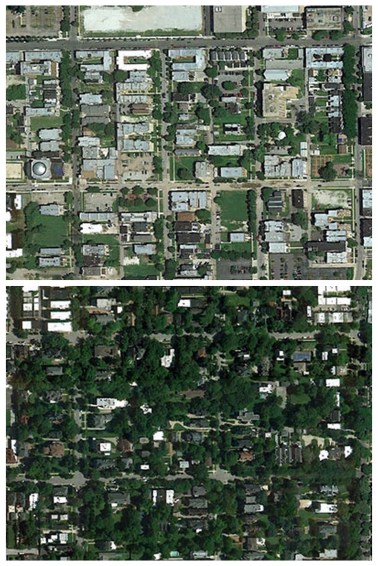So. Man-made things you can see from space:
+The Great Wall of China
+The Pentagon
+Wealth and poverty
Don’t believe me? Here’re photos of Hyde Park (median household income $44,142) and Woodlawn ($21,482), two Chicago neighborhoods. Can you guess which is which?
In response to a study on tree cover and wealth, Per Square Mile, a geography and urban studies blog, found pairs of photos from disparate neighborhoods on Google Earth to prove just how easy it is to see inequality. The author, Tim De Chant, argues that the trees (or lack thereof) aren’t just about making the block beautiful, they keep homes and streets cool, clean the air of types of pollution that can cause asthma and allegedly even fight crime. The response from readers brought photos from Tanzania to Portugal and shows that it’s more than just trees; it’s the size of houses, the presence of cul-de-sacs and the crowding of blocks.

Mexico City: "Although it appears that these satellite images are presented at different scales, I assure you that they were not."
And while there’s a lot we can see from miles up, there’s a lot we miss too. Between education, gentrification, transportation, historical and present-day racism, immigration the politics of housing is a messy business. Pointing out what’s missing from the poorer neighborhoods reinforces ideas about the dangers of “bad parts” of the city; while suggesting that many people in these areas are thriving, if not economically then artistically and socially, seems to overlook the obstacles they face. What these images do give us is a place to start. With some members of congress intent on turning knowledge into a limited resource, the more we see means the better we can talk about the places we live.




I just finished reading a book about poverty and education and it was said how much poverty affects health for students. This leads to amount of days absent which in turn affects test scores, grades, behavior, etc etc…When I think of poverty and health issues I immediately think of our overall health care systems (and lack thereof) but now I will also think of it from an environmental standpoint. Poverty=less greenery=Poor air quality=decreased health. Thanks for bringing awareness to this. I feel like this is something that anyone can help improve…
And then add states that criminalize truancy to the mix… blargh.
Oh! Madam Laura, can you point us towards more examples?
I’d like to see some more ’em.
You can also see how much homes run in your area, or other places on http://www.zillow.com. Check it out, it’s really interesting how much the economy (as well as other variables) has affected certain areas of my neighborhood, as well as others neighborhood and cities around America. And don’t even get me started on the “politics of housing” “building codes” and other such stuff that systematically keep you in debt because you have to buy more “house” than what you actually “need.”
This is really interesting. My neighborhood has a big disparity in wealth; huge Victorian mansions that are valued in the multi-millions just a block away from rent-stabilized apartment buildings. So I looked it up on Google Earth… guess where the houses are and where the buildings are:
http://img444.imageshack.us/img444/9287/picture1le.png
you think google mapping the US shows disparity? try google mapping africa. you can SEE the tin shanty roofs. interesting someone points it out.
The opening line seemed to imply that a median household income of $44000 was well off or comfortable.
Is a median income of $44000 for a household seriously considered high income in America?
In Australia the equivalent of that in our local currency is what a minimum wage unskilled shop assistant would earn if they worked a 38hr week.
Numbers are relative, you’re not factoring in the cost of life in those areas.
Example : if I were to cross the border and move to Switzerland, my salary would be multiplied by 2 or 3 – not factoring in cost of life, I would appear to be 2 or 3 times richer. Yet housing, transportation, taxes, food, health care, insurance and pretty much everything else in this country is 2-3 times more expensive, so actually I wouldn’t be any more well off there than here.
And I’m only talking about the differences between two countries using euro as a currency here, if you add exchange rates in the mix numbers get even more meaningless.
When I told my (American) mother I made $35k in my first job in Australia, she nearly shit a brick.
More on income in the US: http://www.mybudget360.com/how-much-does-the-average-american-make-breaking-down-the-us-household-income-numbers/
I’ve lived in England, Australia (Sydney, Canberra) and the US. While I agree that we do have better salaries by the numbers for sure, the cost of living is way cheaper in the United States. I live in Hawaii which has one of the highest cost of living percentages in the country yet utilities and just everyday things are so much cheaper here in the States. Also, the United States has a much bigger gap between rich and poor and there a lot more of the very rich and of the very poor in the United States compared to Australia. Here in the States, there are Universities that spend as much on their sports stadiums as Australia spends on our major sporting stadiums. I was shocked when heard the numbers when I was watching college football once.
Interestingly enough, being able to see the great wall of china from space with the human eye is a myth.